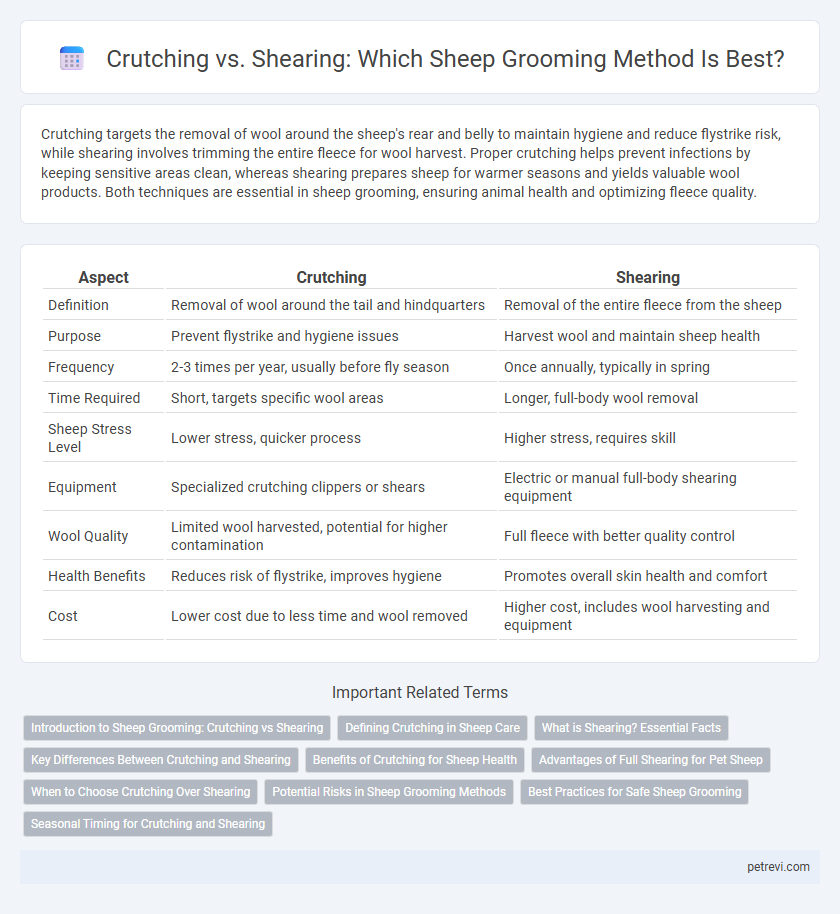Crutching targets the removal of wool around the sheep's rear and belly to maintain hygiene and reduce flystrike risk, while shearing involves trimming the entire fleece for wool harvest. Proper crutching helps prevent infections by keeping sensitive areas clean, whereas shearing prepares sheep for warmer seasons and yields valuable wool products. Both techniques are essential in sheep grooming, ensuring animal health and optimizing fleece quality.
Table of Comparison
| Aspect | Crutching | Shearing |
|---|---|---|
| Definition | Removal of wool around the tail and hindquarters | Removal of the entire fleece from the sheep |
| Purpose | Prevent flystrike and hygiene issues | Harvest wool and maintain sheep health |
| Frequency | 2-3 times per year, usually before fly season | Once annually, typically in spring |
| Time Required | Short, targets specific wool areas | Longer, full-body wool removal |
| Sheep Stress Level | Lower stress, quicker process | Higher stress, requires skill |
| Equipment | Specialized crutching clippers or shears | Electric or manual full-body shearing equipment |
| Wool Quality | Limited wool harvested, potential for higher contamination | Full fleece with better quality control |
| Health Benefits | Reduces risk of flystrike, improves hygiene | Promotes overall skin health and comfort |
| Cost | Lower cost due to less time and wool removed | Higher cost, includes wool harvesting and equipment |
Introduction to Sheep Grooming: Crutching vs Shearing
Sheep grooming involves essential practices like crutching and shearing, both critical for animal health and wool quality. Crutching targets the removal of wool around the sheep's hindquarters to prevent flystrike and maintain hygiene, while shearing entails a full-body wool cut that prepares sheep for seasonal changes and wool harvesting. Effective grooming supports sheep welfare, reduces parasite risks, and optimizes wool production efficiency.
Defining Crutching in Sheep Care
Crutching in sheep care involves the strategic removal of wool from the sheep's hindquarters, particularly around the tail and between the legs, to maintain hygiene and prevent flystrike. This targeted wool trimming reduces the accumulation of dirt and feces, lowering the risk of parasitic infections and promoting the animal's overall health. Unlike full shearing, crutching is a specialized grooming practice aimed at specific problem areas rather than removing the entire fleece.
What is Shearing? Essential Facts
Shearing is the process of cutting off the entire fleece of a sheep in one session to harvest wool, typically done once a year in spring or early summer. This essential grooming practice prevents overheating, reduces parasite infestations, and improves overall sheep health and hygiene. Professional shearers use specialized hand or machine shears to ensure clean, efficient fleece removal while minimizing stress and injury to the sheep.
Key Differences Between Crutching and Shearing
Crutching involves the removal of wool specifically around the sheep's tail and between the hind legs to maintain hygiene and prevent flystrike, while shearing is the process of removing the entire fleece from the sheep. Crutching is a targeted grooming practice performed more frequently throughout the year, whereas shearing is typically done once or twice annually to harvest the wool. The key difference lies in crutching's focus on health maintenance versus shearing's focus on wool production.
Benefits of Crutching for Sheep Health
Crutching enhances sheep health by removing wool around the tail and hindquarters, which significantly reduces the risk of flystrike, a dangerous parasitic infection. This targeted grooming practice also improves hygiene and prevents wool contamination from urine and feces, thereby reducing bacterial infections. Maintaining cleaner fleece and skin promotes better overall welfare and eases monitoring for external parasites and skin conditions.
Advantages of Full Shearing for Pet Sheep
Full shearing offers significant advantages for pet sheep by improving overall hygiene and reducing the risk of flystrike, a common parasitic infection. It promotes better ventilation to the skin, preventing overheating during warmer months, and allows for easier inspection to monitor health issues such as ticks or wounds. Regular full shearing also supports wool regrowth and maintains optimal fleece quality, enhancing the sheep's comfort and appearance.
When to Choose Crutching Over Shearing
Crutching is preferred over shearing when targeting specific areas around the tail and between the rear legs to maintain hygiene and prevent flystrike, especially in warmer months. This method is ideal for managing wool cleanliness without removing the entire fleece, reducing stress for the sheep while addressing key health concerns. Timing crutching before fly season or lambing improves animal welfare and wool quality by minimizing fecal matter accumulation and parasite risks.
Potential Risks in Sheep Grooming Methods
Crutching and shearing both play vital roles in sheep grooming, yet each carries distinct potential risks affecting animal health and welfare. Crutching may lead to skin abrasions and increased susceptibility to flystrike if not done correctly, while improper shearing can cause cuts, stress, and hypothermia, especially in colder climates. Selecting appropriate techniques and skilled handlers minimizes these risks, ensuring sheep remain healthy and comfortable throughout grooming processes.
Best Practices for Safe Sheep Grooming
Crutching and shearing are essential sheep grooming practices that enhance animal welfare by preventing wool soiling and reducing parasite infestation. Best practices for safe sheep grooming include using sharp, well-maintained equipment to minimize stress and injury, handling sheep gently to avoid panic, and ensuring a clean environment to reduce the risk of infections. Regular grooming schedules adapted to breed-specific wool growth patterns optimize comfort and health for the flock.
Seasonal Timing for Crutching and Shearing
Crutching sheep is typically performed in spring to remove wool around the tail and hindquarters, reducing the risk of flystrike during warmer months. Shearing usually occurs once a year in late autumn or early winter to harvest the full fleece and prepare sheep for colder temperatures. Seasonal timing ensures wool quality, animal health, and effective pest control in sheep grooming practices.
Crutching vs Shearing for Sheep Grooming Infographic

 petrevi.com
petrevi.com